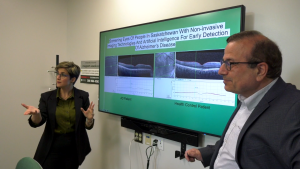Saskatchewan researchers are delving into the world of eye health in hopes of finding early indicators of Alzheimer’s disease.
A team of scientists at the University of Saskatchewan’s College of Medicine is conducting a study to determine if changes in the eye can be used as a potential biomarker for the early detection of Alzheimer’s disease.
The study, led by Dr. Michael Kelly, is focusing on the retina, the thin layer of tissue at the back of the eye responsible for converting light into neural signals that are then sent to the brain for visual processing.
According to Kelly, the retina is an extension of the brain and shares many similarities with it, making it a promising area to explore for potential signs of Alzheimer’s disease.
The research team is using advanced imaging techniques to examine the retina and its blood vessels in individuals with and without Alzheimer’s disease. They are specifically looking for changes in the retina’s thickness, blood flow, and the presence of amyloid plaques, which are a hallmark of Alzheimer’s disease.
If successful, this study could lead to a non-invasive and cost-effective way to detect Alzheimer’s disease in its early stages, allowing for earlier intervention and treatment.
Currently, Alzheimer’s disease is diagnosed through a combination of cognitive tests, brain imaging, and spinal fluid analysis. However, these methods can be invasive, expensive, and may not detect the disease until it has already caused significant damage to the brain.
The research team hopes that by studying the eye, they can identify changes that occur in the early stages of Alzheimer’s disease, providing a more accessible and accurate way to diagnose the disease.
This study is just one of many ongoing efforts to better understand and combat Alzheimer’s disease, which affects an estimated 44 million people worldwide.
The research team is currently recruiting participants for the study, and anyone interested in participating can contact the University of Saskatchewan’s College of Medicine for more information.
While there is still much to learn about Alzheimer’s disease, this study offers hope for a future where early detection and treatment can improve the lives of those affected by this devastating disease.



